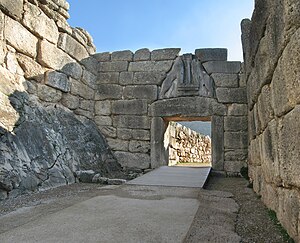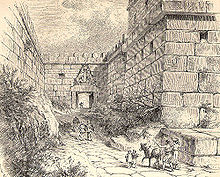Lion Gate (Mycenae)
The Lion Gate is the main gate of the ancient city of Mycenae and is located in the northwest of the fortified complex. It leads to the so-called large ramp , which leads further up through the city to the palace ( megaron ).
The lion gate dates from the middle of the 13th century BC. Chr. It got its name because of the relief to which the relief triangle located above the gate was decorated. It shows two lions facing each other and a column between them. The lion relief is the oldest monumental sculpture in Europe.
layout
The outer path to the gate is lined with a wall about 45 meters long. On the right the gate is protected by a thickening of the wall, which could have served as a tower. This construction forms a 17 meter long and ten meter wide forecourt, which made it easier to defend the entrance. Immediately behind the gate on the right, a narrow staircase leads up to the wall.
The gate consists of a total of four monolith blocks that form an opening 3.1 meters high and three meters wide. The blocks are put together without mortar. The load-bearing monolith blocks have two recesses into which a transom was inserted to close the gate. The gate is said to have consisted of two wooden wings reinforced with bronze. The fishing inlets for the gate leaves can still be seen in the threshold and the lintel.
The lintel consists of a monolith weighing around twelve tons. Above him is the eponymous relief triangle with the lion relief. The lions stand to the left and right of a central, Minoan column that stands on two hollowed-out sacrificial altars . The lion's front legs rest on this pedestal-like base. The column, which is the symbol of the royal house of Mycenae, has a uniquely designed capital . Immediately on the capital cover plate are four circles that are likely to imitate the ends of load-bearing beams of a roof. The heads of the lions are said to have been made of bronze or steatite , but were not found during the excavations.
history
The construction of the gate is attributed to the mythical Mycenaean king Atreus . It is said to have been around 1250 BC. Have been built. Together with the Cyclopean curtain wall, it testifies to the size and unique wealth of the ancient city.
During the first excavations in Mycenae in 1841, under the direction of the Greek archaeologist Kyriakos Pittakis, the Lion Gate was discovered, uncovered and rebuilt. The wall sections in this area were almost completely below the surface. In 1874 Heinrich Schliemann continued the excavations on the entire site.
literature
- E. Karposini-Dimitriadi: The Peloponnese. A traveller's guide to the sites, monuments and history . Ekdotike Athenon SA, Athens 1997, ISBN 960-213-013-X .
Web links
Coordinates: 37 ° 43 ′ 51 ″ N , 22 ° 45 ′ 23.3 ″ E



